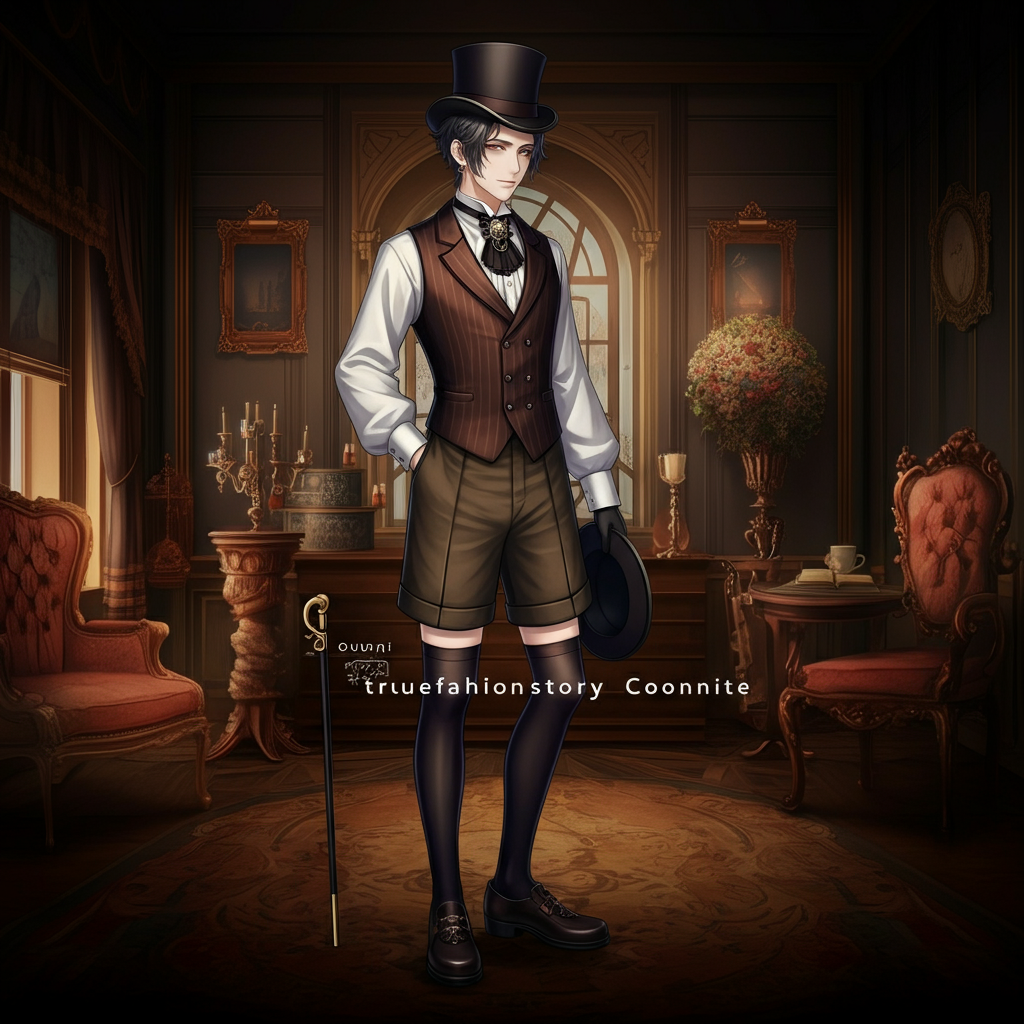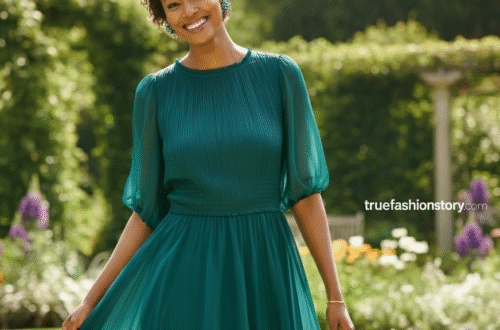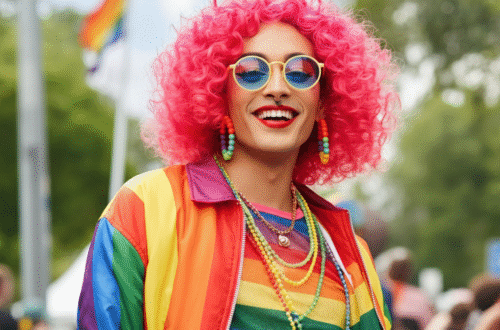Welcome to the world of Ouji fashion, a captivating Japanese street style that is all about embracing a princely, androgynous aesthetic. If you have ever been drawn to Victorian-era clothing for boys, with its tailored shorts, elegant blouses, and knee-high socks, then you have found your niche. Ouji, which means “prince” in Japanese, is the perfect counterpart to Lolita fashion, but it stands proudly on its own as a unique and detailed style.
This guide will walk you through everything you need to know about Ouji fashion. We will explore its history, key elements, and how you can start building your own princely wardrobe. Whether you are completely new to the style or looking to refine your coordinates, you will find valuable tips and inspiration here.
Key Takeaways
- Ouji fashion is a Japanese street style inspired by the historical clothing of young European princes and boys, primarily from the Victorian and Edwardian eras.
- The style is androgynous and can be worn by anyone, regardless of gender. It is often considered the “brother style” to Lolita fashion.
- Key elements include blouses, vests, knickerbockers or shorts, knee-high socks, and classic footwear.
- Accessorizing is crucial, with items like top hats, bow ties, and gloves adding the finishing touches to an Ouji coordinate.
- There are several sub-styles within Ouji, such as Classic, Gothic, and Sweet, allowing for a wide range of personal expression.
What Exactly Is Ouji Fashion?
Ouji fashion is a Japanese style characterized by its masculine and princely look. It draws heavy inspiration from historical European menswear, particularly the clothing worn by young boys during the Victorian era. Think of it as dressing like a storybook prince. The silhouette is formal and elegant, often featuring layers like vests over blouses and paired with shorts or trousers.
While it shares aesthetics with Lolita fashion and is often seen alongside it, Ouji is distinct. It is not simply “Lolita for boys.” Instead, it has its own set of rules and signature pieces. The focus is on a tailored, put-together appearance that is both handsome and a little bit whimsical. It is a style that allows for creativity and personal expression within a classic framework.
The Origins and History of Ouji
The roots of Ouji fashion are intertwined with the rise of Japanese street styles in the late 1990s and early 2000s. As Lolita fashion gained popularity, a demand grew for a complementary masculine style. Brands that catered to the Lolita community began producing items that fit this princely aesthetic.
Magazines like the Gothic & Lolita Bible were instrumental in defining and popularizing the look. They featured photoshoots, style guides, and brand advertisements that showcased Ouji coordinates, giving it a name and a platform. Early on, the style was sometimes called “kodona,” but Ouji has since become the more widely accepted term. The style continues to evolve, with enthusiasts around the world putting their own spin on the classic princely look.
The Core Components of an Ouji Wardrobe
Building an Ouji coordinate, or “coord,” involves combining several key pieces. Each element plays a role in creating the signature silhouette.
Blouses and Shirts
The foundation of most Ouji outfits is a well-made blouse or shirt.
- Classic Blouses: Look for button-down shirts with details like ruffles, pintucks, lace, or a jabot (a frilly cravat). High collars are also a common feature.
- Colors: White, off-white, and black are staples. However, other colors like navy, burgundy, or even pastels can work depending on the specific sub-style you are aiming for.
- Fabrics: Cotton and linen are popular choices for their structure and comfort.
Trousers and Shorts
The choice of bottoms defines the Ouji silhouette.
- Knickerbockers: These are the most iconic choice. Knickerbockers, or pumpkin pants, are short, puffy trousers that gather at the knee. They create a youthful and distinctly historical look.
- Classic Shorts: Tailored shorts that end at or just above the knee are another excellent option. They offer a slightly more mature and streamlined appearance.
- Full-Length Trousers: For a more formal or mature take on Ouji, tailored full-length trousers can be used. They should be well-fitted and often feature classic patterns like pinstripes.
Vests and Waistcoats
A vest, or waistcoat, is a nearly essential layering piece. It adds structure and formality to the outfit, cinching the waist and creating a more polished look. Vests can be simple and solid-colored or feature elaborate patterns like brocade, damask, or stripes. They are worn over the blouse and under a jacket.
Outerwear: Jackets and Capes
Jackets are another layer that can elevate an Ouji coordinate.
- Tailored Jackets: Look for fitted blazers or tailcoats that match the historical aesthetic. Details like brass buttons, contrasting lapels, or military-inspired braiding are common.
- Capes and Cloaks: For a more dramatic flair, a cape or cloak can be a stunning addition. They add a sense of mystery and grandeur, perfect for Gothic or more theatrical Ouji styles.
Essential Ouji Accessories
Accessories are what truly bring an Ouji coordinate to life. They add personality and complete the princely image.
Legwear: Socks and Tights
Legwear is a crucial detail.
- Knee-High Socks: These are the most common choice, especially when wearing shorts or knickerbockers. Solid colors, argyle patterns, or socks with lace trim are all popular.
- Tights: In colder weather, tights can be worn. Choose solid colors or subtle patterns that complement your outfit.
- Over-the-Knee Socks (OTKs): Similar to knee-highs, OTKs offer more coverage and can create a slightly different look.
Footwear: Classic and Elegant Shoes
Your shoes should match the formal tone of the rest of the outfit.
- Oxfords and Derbies: Classic dress shoes are always a safe bet.
- Mary Janes: Buckled shoes, often associated with Lolita, can also work well, adding a touch of sweetness.
- Boots: Ankle boots or mid-calf boots can add a more rugged or military feel to a coordinate.
Headwear: From Top Hats to Berets
A hat is often the crowning glory of an Ouji outfit.
- Top Hats and Mini-Hats: These add a touch of Victorian drama.
- Newsboy Caps and Berets: These offer a more casual, boyish charm.
- Boater Hats: Perfect for summer coordinates, these straw hats add a light, classic touch.
Other Must-Have Accessories
Don’t forget the finishing touches!
- Ties and Bow Ties: A cravat, bow tie, or ribbon tie adds a pop of color and formality at the neckline.
- Gloves: Short, formal gloves in leather or lace are a sophisticated addition.
- Canes and Pocket Watches: These props enhance the historical feel and add a gentlemanly air.
Popular Ouji Sub-styles
Just like Lolita, Ouji has several sub-styles that allow for different interpretations of the princely theme.
|
Sub-style |
Key Characteristics |
Common Colors |
|---|---|---|
|
Classic Ouji |
Elegant and mature. Focuses on historical accuracy and tailored silhouettes. Often uses muted colors and refined patterns like stripes or plaid. |
Brown, navy, cream, forest green, burgundy. |
|
Gothic Ouji |
Dark, dramatic, and mysterious. Incorporates elements of Gothic fashion like crosses, bats, and intricate lace. |
Black, deep red, royal purple, dark blue. |
|
Sweet Ouji |
More youthful and playful. Uses lighter colors, cute prints (like checks or sweets), and boyish charm. Resembles a storybook character. |
Pastel blue, mint, pink, white, light gray. |
|
Sailor Ouji |
Incorporates nautical themes. Features sailor collars, navy and white color schemes, and anchor motifs. |
Navy blue, white, red. |
Classic Ouji
This is the most traditional form of Ouji. It sticks closely to Victorian and Edwardian aesthetics, favoring sophisticated patterns, rich fabrics, and a very put-together look. A Classic Ouji coordinate might feature a tweed vest, tailored brown shorts, and a crisp white blouse. For more inspiration on classic fashion elements, you can check out different style histories on truefashionstory.comBlog.
Gothic Ouji
Gothic Ouji takes the princely silhouette and filters it through a dark, romantic lens. Black is the dominant color, accented with deep jewel tones. Fabrics like velvet and satin are common, and accessories might include silver jewelry, rosaries, or even eyepatchs for a touch of drama.
Sweet Ouji
This sub-style is the lightest and most whimsical. It often overlaps with the “kodona” aesthetic. Think of a young prince from a fairy tale. Coordinates might include pastel knickerbockers, blouses with rounded collars, and playful accessories like plush toys or candy-themed jewelry.
Ouji Fashion vs. Lolita Fashion
While they are often seen as sibling styles, Ouji and Lolita have key differences.
- Silhouette: Lolita fashion is defined by its cupcake or A-line silhouette, achieved with a petticoat. Ouji fashion focuses on a more masculine, streamlined silhouette with shorts or trousers.
- Gender Expression: Lolita is predominantly feminine in its presentation. Ouji is masculine or androgynous and can be worn by people of any gender.
- Inspiration: Lolita draws from Rococo and Victorian eras, focusing on dresses and skirts. Ouji is inspired by the attire of young boys and princes from a similar time period.
Despite these differences, the two styles share a love for detail, elegance, and historical aesthetics. It is very common to see Ouji and Lolita enthusiasts enjoying fashion together.
How to Get Started with Ouji Fashion
Ready to build your first coordinate? Here’s a simple plan.
- Start with the Basics: Invest in a versatile white or black blouse and a pair of black or navy shorts or knickerbockers. These pieces can form the base of many different outfits.
- Add a Vest: A simple black or gray vest is a great starting point. It will instantly make your outfit look more like Ouji.
- Find the Right Socks: A pair of black or white knee-high socks is essential.
- Choose Your Shoes: A pair of simple black or brown dress shoes will work with almost any coordinate.
- Accessorize Thoughtfully: Begin with a simple bow tie or ribbon. As you build your collection, you can add hats, gloves, and other accessories.
Remember, you do not need to buy everything at once. Building a wardrobe takes time. Start with versatile pieces and slowly add more unique items as you discover which sub-styles you like best.
Conclusion
Ouji fashion is a rich and rewarding style that offers a unique way to express yourself. With its blend of historical elegance and androgynous charm, it provides a fantastic creative outlet for anyone drawn to a princely aesthetic. By understanding the core components—from the blouses and knickerbockers to the essential accessories—you can begin to craft your own handsome and sophisticated coordinates. Whether you lean towards the refined look of Classic Ouji, the dark romance of Gothic, or the playful charm of Sweet, there is a place for you in this princely world. So go ahead, find your inner prince, and start your Ouji fashion journey.
Frequently Asked Questions (FAQ)
1. Can girls wear Ouji fashion?
Absolutely! Ouji is an androgynous style that is open to everyone, regardless of gender. Many women and non-binary individuals are prominent members of the Ouji fashion community. The focus is on the masculine style of the clothing, not the gender of the person wearing it.
2. Is Ouji fashion expensive?
Like any niche fashion, the cost can vary. Brand-name items from Japanese labels can be expensive, but it is entirely possible to build a wardrobe on a budget. You can find suitable pieces at thrift stores, on secondhand marketplaces, or by using off-brand items from mainstream retailers. DIY skills can also help you customize pieces to fit the aesthetic.
3. What is the difference between Ouji and Kodona?
The terms are often used interchangeably, but there can be a subtle distinction. “Kodona” (a combination of “kodomo” for child and “otona” for adult) sometimes refers to a more boyish, youthful, and sweet style. “Ouji” (prince) often implies a more mature, elegant, and formal aesthetic. However, today, most people use “Ouji” as the umbrella term for the entire style.
4. Where can I buy Ouji clothing?
You can purchase Ouji fashion from several sources. Japanese brands like Alice and the Pirates, Moi-même-Moitié, and ATELIER BOZ are famous for their Ouji items. You can also use shopping services to buy from Japanese secondhand sites like Mercari JP or Closet Child. Additionally, some indie brands on platforms like Etsy create Ouji-style clothing and accessories.
5. Do I have to follow all the rules?
While there are general guidelines that define the style, fashion is ultimately about personal expression. It is helpful to understand the “rules” so you can create a coordinate that is clearly identifiable as Ouji. Once you are comfortable with the basics, feel free to experiment and inject your own personality into your outfits.





